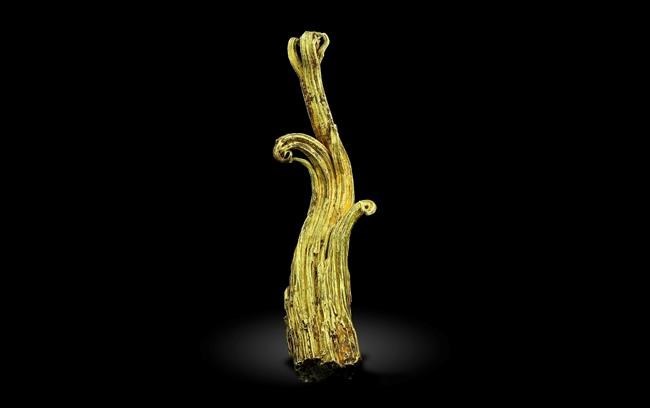
This undated image provided by the Mineralogical and Geological Museum of Harvard University shows a rare gold specimen called the "Ram's Horn." A team of scientists used neutrons from a particle accelerator at Los Alamos National Laboratory in New Mexico to learn more about the specimen's structure and formation process. (Mineralogical and Geological Museum of Harvard University via AP)
Republished February 19, 2019 - 2:51 PM
Original Publication Date February 19, 2019 - 8:26 AM
ALBUQUERQUE, N.M. - Scientists at a premier U.S. laboratory have helped to unravel some of the mysteries about a rare gold specimen discovered at a Colorado mine more than 130 years ago.
Officials at Harvard University's mineral museum were anxious for Los Alamos National Laboratory's assistance in understanding more about the structure of the specimen of wire gold, which looks as if it were formed by twisting together a bunch of thin strands of gold.
The 263-gram specimen is named the Ram's Horn, and Harvard officials have said it is the finest known example of its kind.
No scientific studies previously had been published on the internal nature of the specimen. Its density rendered low-energy X-rays and other diagnostics ineffective, and scientists were prevented from using invasive methods like slicing into the specimen because that would have damaged it.
That's where the half-mile-long (0.8-kilometre-long) particle accelerator at Los Alamos came in. Scientists used neutrons provided by the machine to examine the sample's texture and crystalline structure.
They determined it's very different from more commonly found wire silver, in which a single wire can be made up of hundreds to thousands of crystals.
"The gold appears to be composed of only a few single crystals," said John Rakovan, a professor at Miami University in Ohio who was involved in the work. "Furthermore, we discovered that these samples are not pure gold, but rather gold-silver alloys with as much as 30 per cent silver substituting for gold in the atomic structure."
The study's results could have implications for scientists who are trying to understand the geochemical processes at play in the formation of gold deposits, according to the lab.
The Ram's Horn will go on display as the centerpiece of an exhibit at the Harvard Museum of Natural History in 2020. The show called "The Rare and the Beautiful" will highlight aspects that make objects valuable and how humanity's appreciation for beauty, rarity and culture has shaped those values.
The 4.7-inch-tall (12-centimetre-tall) specimen is normally kept in a bank vault out of sight.
Last fall, it was hand-delivered to New Mexico so the scientists could do their work using the accelerator. It had to be insured while at the lab, but Harvard has declined to say how much the piece is worth.
Harvard began collecting mineral specimens in the 1850s to better understand their crystalline structure. The Ram's Horn was bequeathed to the university in 1947 as part of the collection of A.C. Burrage, a Harvard-educated attorney and businessman who was in the copper industry.
The specimen was found in 1887 at the Ground Hog Mine in Red Cliff, Colorado.
Raquel Alonso-Perez, curator at the Mineralogical and Geological Museum at Harvard, pointed to an 1893 newspaper article about the specimen's discovery and said even then the spirals of gold were considered unique.
Sven Vogel, a physicist at Los Alamos's neutron science centre, said pulses of neutrons from the accelerator usually are used to characterize materials that are relevant to the lab's mission, such as uranium alloys or nuclear fuels.
"These academic collaborations really push the envelope for us," he said. "And of course, it's a lot of fun too to apply these methods and help the universities to gain insight that otherwise they would have no chance to gain."
News from © The Associated Press, 2019